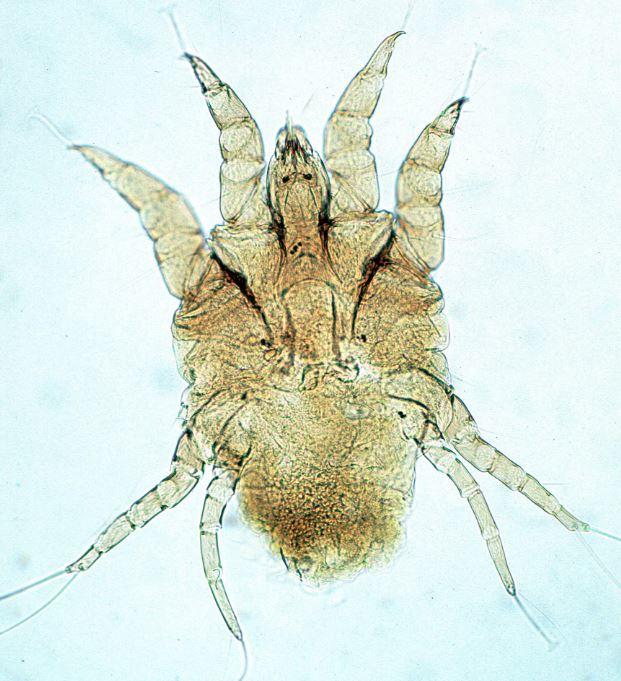Rabbit ear mites refer to the infestation of the parasitic Psoroptes cuniculi which are non-borrowing mites that commonly affect the ear canal and pinna area but can spread to other parts including perianal, abdomen, head and feet.
Usually, these parasites feed on the skin oils and debris. Also, vigorous scratching due to resultant inflammation may cause some blood to ooze out of the skin and provide more nutrients for these parasites.
The Psoroptes cuniculi infestation is one of the common outer ear problems which in severe cases may lead give a good breeding ground for bacteria, yeast and some fungus which may spread to the middle and inner ears causing otitis media and interna respectively.
Finally, although they may not cause death on their own, the fact that they can open a gateway for infection by other pathogenic agents and the discomfort they will cause to these pets, they need to be treated.

Are they contagious to human beings?
No. Psoroptes cuniculi are not zoonotic and they should not be confused for fur mites. Therefore, they will not affect you if your pet has them. However, they can affect goats, horses, and sheep.
However, do not forget it is possible for you to transmit these parasites while handling your pets such as during grooming.
What do rabbit ear mites look like including pictures?
Psoroptes cuniculi cannot be seen with our naked eyes owing to their small size unless you carefully watch them. An adult one is about 0.75mm. They have jointed long legs, suckers and so on. Here is their picture.
Transmission and their lifecycle
The Psoroptes cuniculi parasites transmitted through direct contact or contacts of anything that may have these parasites including scales and crusts from infected rabbits. Bedding, hutches, litter tray, and anything that these pets may have come in contact with can transmit them.
They have a 21-day lifecycle which has the egg, larvae, protonymph and finally the adult mite. Most treatments may not kill eggs.
Symptoms
Infestation by Psoroptes cuniculi may present various clinical signs. Some of the early rabbit mites symptoms include head shaking, ear-shaking and scratching of the ears, neck, and head in general.
When the infestation advances, you will notice thick yellowish to brown exudates as well as waxy deposits on the ear canal which will afterward be noted on the inner side of the pinna. With time, the parasite can spread to other places.
Afterward, there will be crusting, scabbing, fur loss and other ear infection symptoms if bacteria, yeasts or fungus colonize the affected ear. These secondary infections can cause emaciation, deafness, among other disorders.
Diagnosis
If you notice some of the above symptoms, you need to take your bunny to a vet for diagnosis which will include the observation of the various clinical signs, including using an otoscope, taking swabs or skin scrapings for microscopic observation among others.
Mites in rabbits treatment
How to cure ear mites in rabbits? Do you use home remedies or let your vet give your prescriptions? The most effective way to treat these parasites is to let your vet recommend the right treatments. Treatment is by various Rx medications including:
- Selamectin – Stronghold® for those in Europe while Revolution® is used in the US.
- Ivermectin
- Eradimite – This product will kill ear mites, and ticks as well as earwax removal. Safe for your bunnies, dogs, puppies, kitten, and cats.
Since the feces and mucus that these mites produce cause a lot of inflammation, pain-relieving medications may also be prescribed as well as treatments of any other ear infections including yeast, fungal and bacteria is detected.
OTC mite medications should not be used for rabbits as they have pyrethrins and pyrethroids which can harm these animals and will have symptoms such as coma, seizures, tremors, limb paralysis or even result in death.
Home remedies
Mild cases of infestation may be handled using various home remedies including honey, tea tree oil, mineral oils, vegetable oils, white vinegar, yellow dock extracts among others. Only begin using these remedies after your vet gives you ok.
Prevention
How do you prevent ear mites in rabbits? It is simple, follow the below guidelines
- Prevention will involve treating any other bunny that may have been contacted the infected one or accessed any common areas.
- Secondly, any organic materials as well as bedding, littering substrates should be discarded as they may be containing these mites.
- For items you may not discard such as feeding bowls, hay racks, toys, grooming brushes, combs, and so on, disinfect them thoroughly using boric acid containing products available at your local pet stores such as Fleabusters® and Indorex® (UK). They are as safe for both animals and humans.
- Also, thoroughly clean and disinfect their hutches, runs (playpens) and any other place they usually access.
- Finally, avoid overcrowding, keep proper hygiene, groom your rabbits regularly without forgetting to clean their ears and remove earwax.
